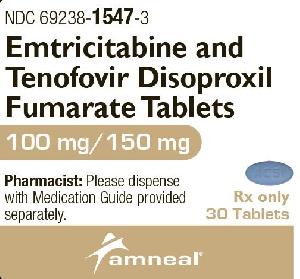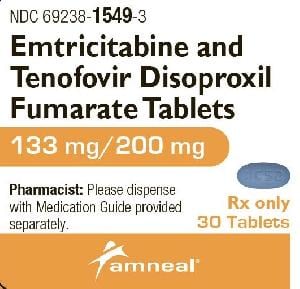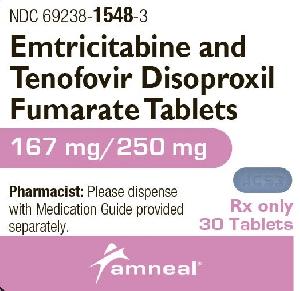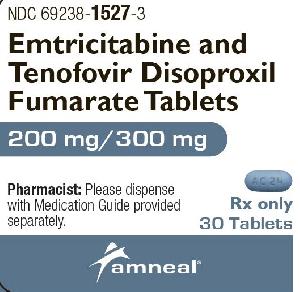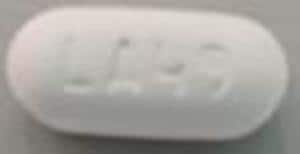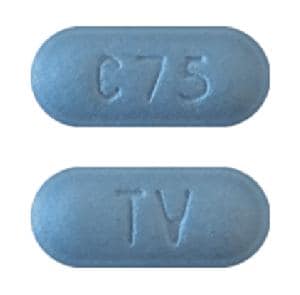Boxed Warning
Posttreatment acute exacerbation of hepatitis B:
Severe, acute exacerbations of hepatitis B virus (HBV) have been reported in HBV-infected patients who discontinue emtricitabine/tenofovir disoproxil fumarate. Closely monitor hepatic function with clinical and laboratory follow-up for at least several months in HBV-infected patients who discontinue emtricitabine/tenofovir disoproxil fumarate. If appropriate, initiation of antihepatitis B therapy may be warranted.
Risk of drug resistance with use for preexposure prophylaxis:
Emtricitabine/tenofovir disoproxil fumarate used for HIV-1 preexposure prophylaxis must only be prescribed to individuals confirmed to be HIV-negative immediately prior to initiating and periodically (at least every 3 months) during use. Drug-resistant HIV-1 variants have been identified with use for HIV-1 preexposure prophylaxis following undetected acute HIV-1 infection. Do not initiate for HIV-1 preexposure prophylaxis if signs or symptoms of acute HIV-1 infection are present unless negative infection status is confirmed.
Dosage Forms
Excipient information presented when available (limited, particularly for generics); consult specific product labeling.
Tablet, Oral:
Truvada: Emtricitabine 100 mg and tenofovir disoproxil fumarate 150 mg, Emtricitabine 133 mg and tenofovir disoproxil fumarate 200 mg, Emtricitabine 167 mg and tenofovir disoproxil fumarate 250 mg, Emtricitabine 200 mg and tenofovir disoproxil fumarate 300 mg [contains fd&c blue #2 aluminum lake]
Pharmacology
Mechanism of Action
Nucleoside and nucleotide reverse transcriptase inhibitor combination; emtricitabine is a cytosine analogue while tenofovir is an analog of adenosine 5'-monophosphate. Each drug interferes with HIV viral RNA dependent DNA polymerase resulting in inhibition of viral replication.
Use: Labeled Indications
HIV-1 infection, treatment: Treatment of HIV-1 infection in combination with other antiretroviral agents in adults and pediatric patients weighing ≥17 kg
HIV-1 infection, preexposure prophylaxis: Preexposure prophylaxis (PrEP) to reduce the risk of sexually acquired HIV-1 infection in at-risk adults and adolescents weighing ≥35 kg, in combination with safer sex practices.
Use: Off Label
Hepatitis B (antiviral-resistant)yes
Based on the AASLD treatment of chronic hepatitis B guidelines, emtricitabine/tenofovir may be considered as an add strategy (2 drugs without cross-resistance) in patients with antiviral resistance due to lamivudine-resistance, entecavir-resistance, or multi-drug resistance.
HIV/Hepatitis B coinfectionyes
Based on the Department of Health and Human Services guidelines for the use of antiretroviral agents in HIV-1 infected adults and adolescents, emtricitabine/tenofovir is effective and recommended as the nucleoside reverse transcriptase inhibitor (NRTI) backbone of a fully suppressive antiretroviral regimen in patients with HIV-1 coinfected with hepatitis B.
HIV-1 nonoccupational postexposure prophylaxisyes
Based on the Centers for Disease Control and Prevention, US Department of Health and Human Services updated guidelines for antiretroviral postexposure prophylaxis after sexual, injection drug use, or other nonoccupational exposure to HIV, emtricitabine/tenofovir (in combination with other antiretrovirals) is effective and recommended for postexposure prophylaxis of HIV-1 infection following nonoccupational exposure (nPEP) in individuals exposed to blood, genital secretions, or other potentially infectious body fluids that may contain HIV when that exposure represents a substantial risk for HIV transmission.
HIV-1 occupational postexposure prophylaxisyes
Based on the US Public Health Service updated guidelines for the management of occupational exposures to human immunodeficiency virus and recommendations for postexposure prophylaxis, emtricitabine/tenofovir (in combination with raltegravir) is an effective and recommended treatment option for postexposure prophylaxis of HIV-1 infection in healthcare personnel following occupational exposure (oPEP) to blood and/or other body fluids that may contain HIV.
HIV-1 infection, preexposure prophylaxis in injecting drug users (IDU)yes
Based on a Centers for Disease Control and Prevention (CDC) Morbidity and Mortality Weekly Report (MMWR), emtricitabine/tenofovir is effective and recommended as pre-exposure prophylaxis (PrEP) of HIV-1 infection in injecting drug users (IDU) who are at risk for parenteral acquisition of HIV but not at risk for sexual acquisition of HIV.
Contraindications
As preexposure prophylaxis in patients with unknown or HIV-1 positive status
Canadian labeling: Additional contraindications (not in US labeling): Hypersensitivity emtricitabine, tenofovir, or any component of the formulation
Dosage and Administration
Dosing: Adult
HIV-1 infection, treatment: Oral: One tablet (emtricitabine 200 mg/tenofovir disoproxil fumarate 300 mg) once daily in combination with other antiretroviral agents.
HIV-1 infection, preexposure prophylaxis (PrEP) in uninfected high-risk individuals: Oral: One tablet (emtricitabine 200 mg/tenofovir 300 mg disoproxil fumarate) once daily
HIV-1 infection, PrEP in injecting drug users (IDU) (off-label use): Oral: One tablet (emtricitabine 200 mg/tenofovir 300 mg disoproxil fumarate) once daily (CDC 2013)
HIV-1/hepatitis B co-infection, treatment (off-label use): Oral: One tablet (emtricitabine 200 mg/tenofovir disoproxil fumarate 300 mg) once daily in combination with other antiretroviral agents (HHS [adult] 2016).
HIV-1 nonoccupational postexposure prophylaxis (nPEP) (off-label use): Oral: One tablet (emtricitabine 200 mg/tenofovir disoproxil fumarate 300 mg) once daily for 28 days in combination with other antiretroviral agents. Initiate therapy within 72 hours of exposure (HHS [nPEP] 2016).
HIV-1 occupational postexposure, prophylaxis (oPEP) (off-label use): Oral: One tablet (emtricitabine 200 mg/tenofovir disoproxil fumarate 300 mg) once daily for 4 weeks with concomitant raltegravir. Initiate therapy as soon as possible after occupational exposure (and within 72 hours) (Kuhar 2013)
Dosing: Geriatric
Refer to adult dosing.
Dosing: Pediatric
HIV-1 infection, treatment: Use in combination with other antiretroviral agents. Note: Multiple tablet strengths exist and contain different amounts of emtricitabine and tenofovir.
Children and Adolescents weighing ≥17 kg and who are able to swallow a tablet whole:
<17 kg: Not intended for use; product is a fixed-dose combination; safety and efficacy have not been established in these patients
17 to <22 kg: Oral: One tablet (emtricitabine 100 mg/tenofovir 150 mg) once daily
22 to <28 kg: Oral: One tablet (emtricitabine 133 mg/tenofovir 200 mg) once daily
28 to <35 kg: Oral: One tablet (emtricitabine 167 mg/tenofovir 250 mg) once daily
≥35 kg: Oral: One tablet (emtricitabine 200 mg/tenofovir 300 mg) once daily
Postexposure prophylaxis, nonoccupational (nPEP) (HHS [nPEP] 2016): Limited data available: Adolescents: Oral: One tablet (emtricitabine 200 mg/tenofovir 300 mg) once daily for 28 days in combination with other antiretroviral agents. Initiate therapy within 72 hours of exposure.
Preexposure prophylaxis (PrEP) in uninfected high-risk individuals: Adolescents weighing ≥35 kg: Oral: One tablet (emtricitabine 200 mg/tenofovir 300 mg) once daily; Note: Patients should be screened for HIV infection prior to initiation of therapy and at least once every 3 months; adherence should also be closely monitored (CDC 2018).
Administration
Oral: May be administered with or without food.
Dietary Considerations
Consider calcium and vitamin D supplementation in patients with history of bone fracture or osteopenia.
Storage
Store tablets at 25°C (77°F); excursions permitted to 15°C to 30°C (59°F to 86°F). Dispense only in original container.
Emtricitabine and Tenofovir Disoproxil Fumarate Images
Drug Interactions
Acyclovir-Valacyclovir: May increase the serum concentration of Tenofovir Products. Tenofovir Products may increase the serum concentration of Acyclovir-Valacyclovir. Monitor therapy
Adefovir: May diminish the therapeutic effect of Tenofovir Products. Adefovir may increase the serum concentration of Tenofovir Products. Tenofovir Products may increase the serum concentration of Adefovir. Avoid combination
Aminoglycosides: May increase the serum concentration of Tenofovir Products. Tenofovir Products may increase the serum concentration of Aminoglycosides. Monitor therapy
Atazanavir: Tenofovir Disoproxil Fumarate may decrease the serum concentration of Atazanavir. Atazanavir may increase the serum concentration of Tenofovir Disoproxil Fumarate. Management: Must use boosted atazanavir in adults; give combo (atazanavir/ritonavir or atazanavir/cobicistat with tenofovir) as a single daily dose with food. Pediatric patients, pregnant patients, and users of H2-blockers require other dose changes. Consider therapy modification
Cabozantinib: MRP2 Inhibitors may increase the serum concentration of Cabozantinib. Monitor therapy
Cidofovir: May increase the serum concentration of Tenofovir Products. Tenofovir Products may increase the serum concentration of Cidofovir. Monitor therapy
Cladribine: Agents that Undergo Intracellular Phosphorylation may diminish the therapeutic effect of Cladribine. Avoid combination
Cobicistat: May enhance the adverse/toxic effect of Tenofovir Products. More specifically, cobicistat may impair proper tenofovir monitoring and dosing. Monitor therapy
Darunavir: Tenofovir Disoproxil Fumarate may increase the serum concentration of Darunavir. Darunavir may increase the serum concentration of Tenofovir Disoproxil Fumarate. Monitor therapy
Diclofenac (Systemic): May enhance the nephrotoxic effect of Tenofovir Products. Management: Seek alternatives to this combination whenever possible. Avoid use of tenofovir with multiple NSAIDs or any NSAID given at a high dose. Consider therapy modification
Didanosine: Tenofovir Disoproxil Fumarate may diminish the therapeutic effect of Didanosine. Tenofovir Disoproxil Fumarate may increase the serum concentration of Didanosine. Management: Avoid concomitant treatment with tenofovir disoproxil fumarate and didanosine. Consider altering even existing, stable treatment to avoid this combination. Avoid combination
Ganciclovir-Valganciclovir: Tenofovir Products may increase the serum concentration of Ganciclovir-Valganciclovir. Ganciclovir-Valganciclovir may increase the serum concentration of Tenofovir Products. Monitor therapy
LamiVUDine: May enhance the adverse/toxic effect of Emtricitabine. Avoid combination
Ledipasvir: May increase the serum concentration of Tenofovir Disoproxil Fumarate. Management: Avoidance of this combination is recommended under some circumstances. Refer to full monograph for details. Consider therapy modification
Lopinavir: May enhance the nephrotoxic effect of Tenofovir Disoproxil Fumarate. Lopinavir may increase the serum concentration of Tenofovir Disoproxil Fumarate. Monitor therapy
Nonsteroidal Anti-Inflammatory Agents: May enhance the nephrotoxic effect of Tenofovir Products. Management: Seek alternatives to these combinations whenever possible. Avoid use of tenofovir with multiple NSAIDs or any NSAID given at a high dose. Consider therapy modification
Orlistat: May decrease the serum concentration of Antiretroviral Agents. Monitor therapy
Simeprevir: Tenofovir Disoproxil Fumarate may decrease the serum concentration of Simeprevir. Simeprevir may increase the serum concentration of Tenofovir Disoproxil Fumarate. Monitor therapy
Tipranavir: Tenofovir Disoproxil Fumarate may decrease the serum concentration of Tipranavir. Tipranavir may decrease the serum concentration of Tenofovir Disoproxil Fumarate. Monitor therapy
Velpatasvir: May increase the serum concentration of Tenofovir Disoproxil Fumarate. Monitor therapy
Voxilaprevir: Tenofovir Disoproxil Fumarate may increase the serum concentration of Voxilaprevir. Voxilaprevir may increase the serum concentration of Tenofovir Disoproxil Fumarate. Monitor therapy
Adverse Reactions
Also see individual agents.
>10%: Neuromuscular & skeletal: Decreased bone mineral density (13%)
1% to 10%:
Central nervous system: Headache (7%)
Endocrine & metabolic: Weight loss (3%)
Gastrointestinal: Abdominal pain (4%)
Hematologic & oncologic: Abnormal phosphorus levels (<2.0 mg/dL: 10%), decreased neutrophils (5%)
Neuromuscular & skeletal: Bone fracture (2%)
<1%, postmarketing, and/or case reports: Glycosuria, immune reconstitution syndrome, proteinuria
Warnings/Precautions
Concerns related to adverse effects:
- Decreased bone mineral density: In clinical trials, tenofovir disoproxil fumarate has been associated with decreases in bone mineral density in HIV-1 infected adults and increases in bone metabolism markers. Serum parathyroid hormone and 1,25 vitamin D levels were also higher. Decreases in bone mineral density have also been observed in clinical trials of HIV-1 infected pediatric patients. Observations in chronic hepatitis B infected pediatric patients (aged 12-18 years) were similar. In all pediatric clinical trials, skeletal growth (height) appears unaffected. Consider monitoring of bone density in adult and pediatric patients with a history of pathologic fractures or with other risk factors for bone loss or osteoporosis. Consider calcium and vitamin D supplementation for all patients; effect of supplementation has not been studied but may be beneficial. Long-term bone health and fracture risk unknown. If abnormalities are suspected, expert assessment is recommended.
- Immune reconstitution syndrome: Patients may develop immune reconstitution syndrome resulting in the occurrence of an inflammatory response to an indolent or residual opportunistic infection during initial HIV treatment or activation of autoimmune disorders (eg, Graves’ disease, polymyositis, Guillain-Barré syndrome) later in therapy; further evaluation and treatment may be required.
- Lactic acidosis/hepatomegaly: Lactic acidosis and severe hepatomegaly with steatosis, sometimes fatal, have been reported with use of nucleoside analogues, alone or in combination with other antiretrovirals. Suspend treatment in any patient who develops clinical or laboratory findings suggestive of lactic acidosis or pronounced hepatotoxicity (marked transaminase elevation may/may not accompany hepatomegaly and steatosis).
- Osteomalacia and renal dysfunction: May cause osteomalacia with proximal renal tubulopathy. Bone pain, extremity pain, fractures, arthralgias, weakness and muscle pain have been reported. In patients at risk for renal dysfunction, persistent or worsening bone or muscle symptoms should be evaluated for hypophosphatemia and osteomalacia.
- Renal toxicity: Tenofovir disoproxil fumarate may cause renal toxicity (acute renal failure and/or Fanconi syndrome); avoid use with concurrent or recent nephrotoxic therapy (including high dose or multiple NSAID use). Acute renal failure has occurred in HIV-infected patients with risk factors for renal impairment who were on a stable tenofovir regimen to which a high dose or multiple NSAID therapy was added. Consider alternatives to NSAIDS in patients taking tenofovir disoproxil fumarate and at risk for renal impairment. Calculate creatinine clearance and assess serum creatinine, urine glucose, and urine protein prior to initiation of therapy and as clinically appropriate during therapy. In patients with chronic kidney disease, also assess serum phosphorous. IDSA guidelines recommend discontinuing tenofovir (and substituting with alternative antiretroviral therapy) in HIV-infected patients who develop a decline in GFR (a >25% decrease in GFR from baseline and to a level of <60 mL/minute/1.73 m2) during use, particularly in presence of proximal tubular dysfunction (eg, euglycemic glycosuria, increased urinary phosphorus excretion and hypophosphatemia, proteinuria [new onset or worsening]) (IDSA [Lucas 2014]).
Disease-related concerns:
- Chronic hepatitis B: [US Boxed Warning]: Acute, severe exacerbations of HBV have been reported in HBV-infected patients following discontinuation of antiretroviral therapy. Closely monitor hepatic function with clinical and laboratory follow-up for at least several months in patients infected with HBV who discontinue this therapy. If appropriate, anti-hepatitis B therapy may be warranted, especially in patients with advanced liver disease or cirrhosis. All patients with HIV should be tested for HBV prior to initiation of treatment; HBV-uninfected patients should be offered vaccination.
- Comprehensive prevention program: Preexposure prophylaxis (PrEP) should be accompanied by a comprehensive HIV-1 prevention program (eg, risk reduction counseling, access to condoms), with particular emphasis on medication adherence. In addition, regular monitoring (eg, HIV status of patient and partner(s), risk behavior, adherence, adverse effects, sexually transmitted infections that facilitate HIV-1 transmission) is highly recommended.
- HIV treatment and renal impairment: Use with caution in patients with renal impairment (CrCl <50 mL/minute); dosage adjustment required. Do not use in patients with CrCl <30 mL/minute or requiring hemodialysis. IDSA guidelines recommend avoiding tenofovir in HIV patients with preexisting kidney disease (CrCl <50 mL/minute and not on hemodialysis or GFR <60 mL/minute/1.73 m2) when other effective HIV treatment options exist because data suggest risk of chronic kidney disease (CKD) is increased (IDSA [Lucas 2014]).
- PrEP and renal impairment: Do not use in CrCl <60 mL/minute.
- Resistance risk with PrEP: [US Boxed Warning]: Confirm HIV-1 negative status immediately before and at least every 3 months during therapy. Do not start PrEP if signs or symptoms of acute HIV-1 infection are present unless HIV-1 negative status is confirmed by a test approved by the Food and Drug Administration (FDA) as an aid to detect HIV-1 infection (including acute or primary infection). Risk of drug resistant HIV-1 variants with PrEP use if patient had undetected acute HIV-1 infection. Some HIV-1 tests (eg, rapid tests) do not detect acute HIV-1 infection. Screen PrEP candidates for acute viral infections and potential exposure events within 1 month of starting PrEP. If infections or events exist, wait 1 month to start PrEP and reconfirm HIV-1 negative status. If a screening test indicates possible HIV-1 infection or if symptoms of acute HIV-1 infection develop after a potential exposure, convert the HIV-1 PrEP regimen to an HIV-1 treatment regimen until negative infection status is confirmed.
Concurrent drug therapy issues:
- Drug-drug interactions: Potentially significant interactions may exist, requiring dose or frequency adjustment, additional monitoring, and/or selection of alternative therapy. Consult drug interactions database for more detailed information.
- Duplicate therapy: Do not use concurrently with emtricitabine, lamivudine, tenofovir disoproxil fumarate, tenofovir alafenamide, or any combination of these drugs.
Monitoring Parameters
CBC with differential, reticulocyte count, creatine kinase, CD4 count, HIV RNA plasma levels, serum phosphorus; serum creatinine, urine glucose and urine protein (prior to initiation and as clinically indicated during therapy), hepatic function tests, bone density (patients with a history of bone fracture or have risk factors for bone loss); testing for HBV is recommended prior to the initiation of antiretroviral therapy; weight (children).
Patients with HIV and HBV coinfection should be monitored for several months following tenofovir discontinuation.
HIV-1 preexposure prophylaxis (PrEP) (CDC 2011; CDC 2012): Pregnancy test for women receiving PrEP (every visit); documented negative HIV test (immediately prior to use, every 2-3 months, and following discontinuation of PrEP), assess risk behaviors and symptoms of sexually-transmitted infections (STIs) or acute HIV-1 infection and provide condoms (immediately prior to use, then every 2-3 months during therapy); BUN and serum creatinine (prior to initiation, 3 months after initiation, then every 6 months); urine glucose and urine protein (in patients at risk for renal impairment or who experienced renal impairment while taking adefovir); serum phosphorus in patients with chronic kidney disease, testing for HBV (prior to initiation) and STIs (prior to initiation, then at least every 6 months, even if asymptomatic)
HIV occupational postexposure prophylaxis (PEP) (Kuhar 2013): Documented HIV test (at baseline and 6 weeks, 12 weeks and 6 months after exposure); if confirmation that a fourth generation HIV p2 antigen-HIV antibody test is being used, monitor at baseline, 6 weeks and 4 months after exposure. CBC, renal and hepatic function assessments at baseline and 2 weeks after exposure (minimum recommendations, others dictated by clinical assessment)
Pregnancy
Pregnancy Considerations
The Health and Human Services (HHS) perinatal HIV guidelines consider emtricitabine with tenofovir disoproxil fumarate to be a preferred nucleoside reverse transcriptase inhibitor backbone for initial therapy in antiretroviral-naive pregnant females. Emtricitabine with tenofovir disoproxil fumarate may also be recommended as part of a regimen when acute HIV infection is detected during pregnancy. In addition, this combination is preferred for use in pregnant females living with HIV who have had antiretroviral therapy (ART) in the past but are restarting, who require a new ART regimen (due to poor tolerance or poor virologic response of current regimen), and who are not yet pregnant but are trying to conceive. Females who become pregnant while taking this combination may continue if viral suppression is effective and the regimen is well tolerated.
The HHS perinatal guidelines also recommend emtricitabine plus tenofovir disoproxil fumarate as a component of regimens for HIV/hepatitis B virus-coinfected pregnant females.
In addition, this combination is recommended for pre-exposure prophylaxis in couples with discordant HIV status who are planning a pregnancy. The partner without HIV should begin therapy 1 month prior to and continue for 1 month after conception is attempted (HHS [perinatal] 2019).
Refer to individual monographs for additional information.
Patient Education
- Discuss specific use of drug and side effects with patient as it relates to treatment. (HCAHPS: During this hospital stay, were you given any medicine that you had not taken before? Before giving you any new medicine, how often did hospital staff tell you what the medicine was for? How often did hospital staff describe possible side effects in a way you could understand?)
- Patient may experience nausea, diarrhea, trouble sleeping, dizziness, headache, nightmares, weight loss, or loss of strength and energy. Have patient report immediately to prescriber signs of lactic acidosis (fast breathing, fast heartbeat, abnormal heartbeat, vomiting, fatigue, shortness of breath, severe loss of strength and energy, severe dizziness, feeling cold, or muscle pain or cramps), signs of liver problems (dark urine, fatigue, lack of appetite, nausea, abdominal pain, light-colored stools, vomiting, or yellow skin), signs of kidney problems (unable to pass urine, blood in the urine, change in amount of urine passed, or weight gain), depression, bone pain, muscle pain, muscle weakness, painful extremities, or signs of infection (HCAHPS).
- Educate patient about signs of a significant reaction (eg, wheezing; chest tightness; fever; itching; bad cough; blue skin color; seizures; or swelling of face, lips, tongue, or throat). Note: This is not a comprehensive list of all side effects. Patient should consult prescriber for additional questions.
Intended Use and Disclaimer: Should not be printed and given to patients. This information is intended to serve as a concise initial reference for health care professionals to use when discussing medications with a patient. You must ultimately rely on your own discretion, experience, and judgment in diagnosing, treating, and advising patients.
